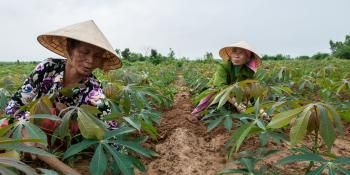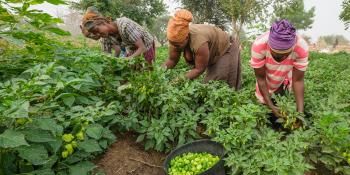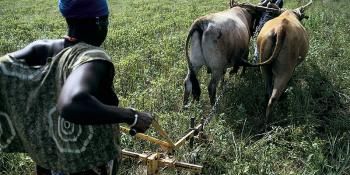Hamburgers and yamburgers? Four-degree futures for food in Africa

Optimistic scientists are holding out for a maximum 2 degree rise in mean global temperatures by the end of the century. But the consensus is changing. Even if current global mitigation pledges are fully delivered, we will reach +3.5C by 2100. The UK Met Office says a 4 degree world is quite possible, and will plausibly be reached by 2070 or even 2060 – in our children’s lifetimes. This will mean average temperature rises of a massive 15C in the Arctic, and 3-8C in the world’s most populated areas.
Forward-thinking policy-makers rightly assert that adaptation in agriculture should be homegrown as far as possible, centred on local knowledge and local innovation. But what if farmers are confronted with conditions completely unlike anything that they have experienced in their lifetimes? Agriculture is highly sensitive even to a 2 degree scenario; a 4 degree world is beyond the bounds of both local and global knowledge, both modern and historical experience. By 2050 a quarter of African countries – mainly in the Sahel – will be experiencing crop growing conditions for which there are no current analogues globally.
A new paper, Agriculture and food systems in sub-Saharan Africa in a four-plus degree world, by Philip Thornton, Peter Jones, Polly Ericksen and Andrew Challinor, foresees profound effects. In short, 4 degrees cuts down both the range of potential adaptation options and the efficacy of those options. Different crop models give different estimates, but ensembles of models suggest average yield drops of 19% for maize and 47% for beans, and much more frequent crop failures. Furthermore, the cultivars of maize that can produce reliable yields at +4 degrees are only a small fraction of current varieties. Africa-wide, a massive 1.2 million km2 may be forced to flip from typical mixed farms, with both crops and livestock, into pure rangeland. To put this loss into perspective, current estimates of cropland in Africa range from 1 to 6 million km2 (yes, even our most basic agricultural data are poor).
Thus a 4 degree world calls for adaptive capacity in agriculture that is not just about increasing the resilience of current systems, but about completely new ways of farming and consuming. The policy challenge is to open more opportunities for African smallholders, not to narrow their options. Solutions will not be purely technical or agricultural – they will include new markets and diversification of off-farm livelihoods. Thornton and colleagues highlight four areas for immediate policy attention: supporting farmers’ own risk-management strategies, strengthening basic data collection in agriculture, investing seriously in genebanks, and improving governance of food systems so that poor people can get affordable food.
Thornton and colleagues also argue that Africa will not be able to rely on global grain markets to fill future yield gaps. Rapidly urbanising populations will need to eat nationally and regionally grown food. If +4 degrees signals the end to half a millennium of Africans eating maize, will the 21st century usher in a new era of indigenous urban foods, be they free-range hamburgers or drought-resistant yamburgers?
The study appears in the British journal Philosophical Transactions of the Royal Series A. The authors of the paper welcome your comments below on four-degree futures for food in Africa.
This blog was written by Sonja Vermeulen, CCAFS Deputy Director of Research. You can subscribe to receive Sonja's monthly science-policy bulletin, 'AgClim Letters', in your inbox. Sign up here.



